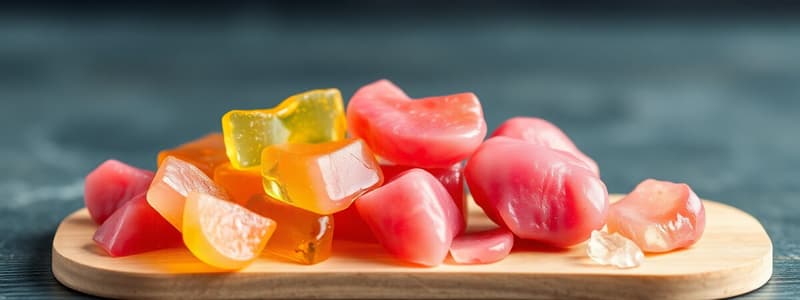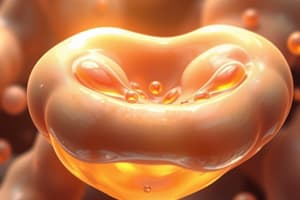Podcast
Questions and Answers
What is the primary energy source during mild exercise at 25 percent VO2 max?
What is the primary energy source during mild exercise at 25 percent VO2 max?
- Protein
- Amino acids
- Carbohydrates
- Fat (correct)
What limits fat oxidation during high-intensity exercise (≥85 percent VO2 max)?
What limits fat oxidation during high-intensity exercise (≥85 percent VO2 max)?
- Increased carbohydrate availability (correct)
- High plasma FFA levels
- Increased fat mobilization
- Greater muscle triglyceride storage
Which hormone stimulates the release of fatty acids from adipose cells to muscle during exercise?
Which hormone stimulates the release of fatty acids from adipose cells to muscle during exercise?
- Insulin
- Cortisol
- Glucagon
- Epinephrine (correct)
What happens to free fatty acid (FFA) oxidation as exercise intensity increases?
What happens to free fatty acid (FFA) oxidation as exercise intensity increases?
Which factor can inhibit fatty acid oxidation during exercise?
Which factor can inhibit fatty acid oxidation during exercise?
What is the role of triglycerides stored in muscle cells during exercise?
What is the role of triglycerides stored in muscle cells during exercise?
How does carbohydrate intake affect fat oxidation during exercise?
How does carbohydrate intake affect fat oxidation during exercise?
What is the approximate caloric storage in triglycerides within adipose cells?
What is the approximate caloric storage in triglycerides within adipose cells?
What is the recommended adequate intake of linoleic acid for adult males?
What is the recommended adequate intake of linoleic acid for adult males?
What might excessive consumption of dietary fat lead to in terms of physical performance?
What might excessive consumption of dietary fat lead to in terms of physical performance?
How does dietary fat primarily enter the body?
How does dietary fat primarily enter the body?
What do very low-density lipoproteins (VLDL) mainly contain?
What do very low-density lipoproteins (VLDL) mainly contain?
What are the consequences of a diet low in saturated fats for cholesterol intake?
What are the consequences of a diet low in saturated fats for cholesterol intake?
Which type of fatty acid is alpha-linolenic acid classified as?
Which type of fatty acid is alpha-linolenic acid classified as?
What role do bile salts and lipases play in lipid metabolism?
What role do bile salts and lipases play in lipid metabolism?
What happens to lipids once they are absorbed into the intestinal cells?
What happens to lipids once they are absorbed into the intestinal cells?
What effect does exercise training have on fat metabolism during exercise?
What effect does exercise training have on fat metabolism during exercise?
Which factor is mentioned as a potential ergogenic strategy related to fat metabolism?
Which factor is mentioned as a potential ergogenic strategy related to fat metabolism?
How do high-fat diets theoretically help delay the onset of fatigue?
How do high-fat diets theoretically help delay the onset of fatigue?
What is a notable finding regarding acute high-fat diets and aerobic endurance performance?
What is a notable finding regarding acute high-fat diets and aerobic endurance performance?
What is the percentage of energy that chronic high-fat diets typically provide from fat?
What is the percentage of energy that chronic high-fat diets typically provide from fat?
What happens to muscle triglyceride levels with chronic high-fat diets?
What happens to muscle triglyceride levels with chronic high-fat diets?
Which of the following is NOT a proposed ergogenic supplement associated with fat metabolism?
Which of the following is NOT a proposed ergogenic supplement associated with fat metabolism?
What is a key advantage of increased fat oxidation due to training?
What is a key advantage of increased fat oxidation due to training?
What effect does HCA have on endurance performance in humans?
What effect does HCA have on endurance performance in humans?
What is the main conclusion about CLA supplementation in resistance-trained athletes?
What is the main conclusion about CLA supplementation in resistance-trained athletes?
What is the impact of high-fat diets on exercise performance according to the findings?
What is the impact of high-fat diets on exercise performance according to the findings?
Which of the following is a characteristic of coronary heart disease?
Which of the following is a characteristic of coronary heart disease?
What is suggested about the adherence to a high-fat diet?
What is suggested about the adherence to a high-fat diet?
Which of the following diseases is classified as a cardiovascular disease?
Which of the following diseases is classified as a cardiovascular disease?
What is identified as a primary risk factor for chronic diseases related to dietary fat?
What is identified as a primary risk factor for chronic diseases related to dietary fat?
What has some research indicated regarding ketone supplements and endurance performance?
What has some research indicated regarding ketone supplements and endurance performance?
What is a critical factor associated with the development of atherosclerosis?
What is a critical factor associated with the development of atherosclerosis?
Which cholesterol ratio indicates average risk for atherosclerosis?
Which cholesterol ratio indicates average risk for atherosclerosis?
How can lifestyle changes potentially affect serum LDL-cholesterol levels?
How can lifestyle changes potentially affect serum LDL-cholesterol levels?
Which condition is characterized by high total cholesterol?
Which condition is characterized by high total cholesterol?
Which statement is true regarding HDL-cholesterol?
Which statement is true regarding HDL-cholesterol?
According to the guidelines, what is a desirable level of LDL-cholesterol?
According to the guidelines, what is a desirable level of LDL-cholesterol?
What is the impact of triglycerides on atherosclerosis risk?
What is the impact of triglycerides on atherosclerosis risk?
What role do statins play in cholesterol regulation?
What role do statins play in cholesterol regulation?
Flashcards are hidden until you start studying
Study Notes
Essential Fatty Acids
- Linoleic acid is an essential omega-6 fatty acid with AI of 17g for males and 12g for females.
- Alpha-linolenic acid is an essential omega-3 fatty acid with AI of 1.6g for males and 1.1g for females.
- Cholesterol intake should be between 100-300mg/day when following a low-saturated fat diet.
Excessive Fat & Cholesterol Consumptions
- May be linked to heart disease and obesity.
- Can displace carbs in diet, leading to excess calorie intake and body weight.
- Can cause gastrointestinal distress.
Fat Metabolism
- 98% of dietary fat is triglycerides, and 2% is made up of sterols and phospholipids.
- Bile salts & lipases digest fats into free fatty acids (FFAs), glycerol, cholesterol, and phospholipids.
- Digested lipids are absorbed into intestinal cells and form chylomicrons, entering lymphatic system.
Lipoprotein Schematic
- Chylomicrons are formed in the intestinal cells and contain a core of triglycerides with phospholipids and cholesterol arranged around the outside.
- VLDL, LDL, and HDL lipoproteins transport lipids throughout the body.
Lipid Absorption
- Chylomicrons enter circulation for breakdown, delivering fats to muscle and adipose (fat) cells.
- Some fats, like MCTs, are taken directly to the liver.
Lipid Circulation
- Chylomicrons circulate in the body to deliver lipids.
- Body cells store lipids as triglycerides in adipose cells and muscle cells (IMTG).
- Liver continually modifies lipoprotein composition.
Lipoprotein Types
- Very low-density lipoproteins (VLDL) are primarily triglycerides and deliver fatty acids and glycerol to cells.
- Most fat is stored in adipose cells for energy.
Fat as an Energy Source
- Plasma chylomicrons & triglycerides are a minor source of energy for exercise.
- Adipose cells have hormone-sensitive lipase which releases FFAs, raising serum FFA for muscle delivery.
- Muscle cells have enzymes that release FFAs for use during exercise.
- Epinephrine increases FFA release from adipose triglycerides to muscle.
Fat Use During Exercise
- Mild exercise (25% VO2 max) uses ~80% of energy from fat, mostly from adipose tissue.
- Up to 65% VO2 max, fat and carbohydrates contribute equally to energy expenditure.
- Intensity ≥85% VO2 max relies on carbohydrates more heavily, dropping fat use to ≤25% as muscle glycogen becomes primary source.
- Overall, FFA oxidation decreases as carbohydrate oxidation increases with higher exercise intensity.
Fat Use Limitations
- Inadequate FFA mobilization can limit delivery to the muscle.
- Impaired intramuscular metabolism can limit fat oxidation.
- Increased carbohydrate oxidation can inhibit fatty acid oxidation.
Dietary Effects on Fat & Exercise
- Lower carbohydrate intake decreases fat oxidation due to increased insulin inhibiting lipolysis and FFA oxidation.
- Carbohydrate intake optimizes endurance performance.
- As carb stores decrease and FFA use increases, exercise intensity must decrease.
Sex and Fat Use
- Some studies show females oxidize more fat than males during submaximal exercise.
- Other studies show no difference in carbohydrate or fat metabolism during exercise in equally trained individuals.
Exercise Training and Fat Metabolism
- Exercise adapts the body to enhance fat utilization and aerobic performance.
- Increased gene expression in skeletal muscles improves the capacity for fat oxidation.
- With training, more energy from fat is used in exercise, sparing muscle glycogen.
Ergogenic Supplements
- High-fat diets, fasting, lipid infusion, MCTs, lecithin, glycerol, omega-3s, hydroxycitrate, conjugated linoleic acid, phosphatidylserine, ketones, and caffeine have all been proposed as ergogenic supplements but research is mixed.
High-Fat Diets
- Theory is that high-fat diets elevate serum FFAs and muscle triglyceride levels for increased fat use and glycogen sparing.
- Acute high-fat diets (fat loading) do not enhance aerobic performance and may impair it if GI distress is caused.
- Chronic high-fat diets don't enhance endurance performance and may not affect fat metabolism in sedentary or trained cyclists.
Conjugated Linoleic Acid (CLA)
- CLA is marketed as a fat loss and muscle gain aid for athletes.
- Limited research suggests no impact on body mass, fat mass, fat-free mass, or strength in resistance-trained athletes.
Ketone Supplements
- Research is mixed, with some suggesting improved performance while others show impaired performance.
- Poor gastrointestinal tolerance.
Ergogenic Fat-Burning Strategies Conclusion
- Increased serum FFA availability and fat oxidation does not improve endurance exercise capacity.
- High-fat diets may impair exercise performance.
- Adherence to high-fat diets is challenging.
Dietary Fats & Cholesterol Health Implications
- Dietary fat as a risk factor for chronic disease is associated with the type and amount of fat consumed.
- A moderate fat diet reduces risk of chronic disease, emphasizing moderation.
Cardiovascular Disease Development
- Many cardiovascular diseases exist, including coronary heart disease (leading cause of death), stroke, hypertension, rheumatic heart disease, and congenital heart disease.
Heart & Coronary Arteries
- Coronary arteries supply the heart with blood.
- Blockage of coronary arteries restricts blood flow and can cause heart attack.
Coronary Heart Disease
- Arteriosclerosis is the thickening and loss of elasticity in arterial walls.
- Atherosclerosis is the formation of plaque in arterial walls.
Atherosclerosis Development
- Plaque buildup leads to narrowing of arteries and potentially blockage, causing thrombosis (blood clot formation).
Serum Lipids and Atherosclerosis
- Total cholesterol, LDL-cholesterol, and triglycerides should be low.
- HDL-cholesterol should be high.
- Cholesterol ratios: TC/HDL (4.5 average risk) and LDL/HDL (3.5 average risk) should be low.
Risk Factors for Atherosclerosis
- High Total Cholesterol
- High LDL-cholesterol
- High Dense LDL
- High IDL-cholesterol
- High Lipoprotein (a) (abnormal form)
- High Apolipoprotein B
- High Triglycerides
- Low HDL-cholesterol
- Low HDL-2-cholesterol
- Low Apolipoprotein A-I
National Cholesterol Education Guidelines
- Total Cholesterol: <200 desirable, 200-239 borderline high, ≥240 high
- HDL Cholesterol: <40 low, ≥60 protective
- LDL Cholesterol: <100 optimal, 100-129 near optimal, 130-159 borderline high, 160-189 high, ≥190 very high
- Triglycerides: <150 normal, 151-199 borderline high, 200-499 high, ≥500 very high
Reversing Atherosclerosis
- Each 1% reduction in LDL cholesterol can decrease risk of coronary heart disease by 1%.
- Lifestyle changes, diet, exercise, and statin drugs are important in managing cholesterol levels.
- Statins inhibit enzymes that regulate cholesterol.
Studying That Suits You
Use AI to generate personalized quizzes and flashcards to suit your learning preferences.




